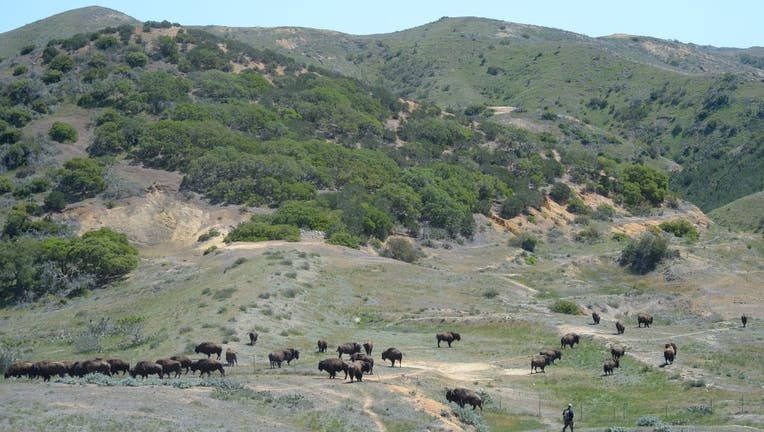Bison plan for California's Catalina Island stirs debate

CATALINA ISLAND, CA - APRIL 14: Catalina Conservancy marine biologist Calvin Duncan looks for a specific female bison to shoot with a dart that will deliver contraceptive to the animal. The conservancy is working to keep the bison population around 1
AVALON, Calif. - The nonprofit organization that owns a majority of California's Santa Catalina Island plans to boost eco-tourism by adding more bison to existing herds, recharging a debate over the environmental impacts of the shaggy beasts.
The Catalina Island Conservancy said there has not been a bison calf born on the island in seven years and the herd size has dwindled to 100, The Los Angeles Times reports.
The conservancy board is working with the Laramie Foothills Bison Conservation Herd to bring two pregnant bison to Catalina Island, about 22 miles south of Palos Verdes Peninsula.
The descendants of 14 bison left by a movie crew in 1924 attract eco-tourists roam Catalina’s 76 square miles of mountains, valleys and grasslands. Homes in the community of 4,000 permanent residents are festooned with painted bison images and gift shops sell bison figurines.
The conservancy runs eco-tours priced at $79 for two hours and $119 for three hours. The Catalina Island Company also offers “Bison Expedition” tours priced around $90 for adults.
“The number one thing that tourists want to see when they come to Catalina is bison and people want to see them running wild rather in a fenced enclosure," Catalina Island Conservancy President Tony Budrovich said.
Bison sighting has been increasingly difficult since 2009 when the conservancy launched a $200,000, five-year program to limit the population. The program aimed to use inoculation to reduce herd size to about 150, which would be healthier and less environmentally damaging.
A 2003 study, when there were 350 bison, concluded the animals trampled native plant communities, altered tree canopies by rubbing against tree trunks and dispersed nonnative grasses through their droppings.
Conservancy officials said bison health improved after the herd was reduced significantly in 2005 by sending some bison for slaughter or to breeding programs. The program was supposed to have been reversible once inoculations ceased.
Former conservancy biologist Calvin Duncan said the island's bison remain in poor health, which may contribute to their inability to produce calves. Blood analysis revealed nutritional deficiencies, while there were observations of broken and brittle horns and emaciated animals.
Eco-tourism customers follow the same assigned routes each day, but bison herds stay on remote, isolated patches of grass, Duncan said.
“Simply adding more bison will not result in more bison sightings," Duncan said.

